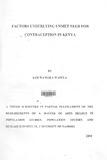| dc.description.abstract | The levels of unmet need for contraception are not only high but the underlying causes behind the observed levels are poorly understood. This study utilizes data drawn from the 1998 K.DHS to examine the magnitude of unmet need for contraception by selected characteristics and to assesses the factors that explain the various components of unmet need for contraception. The unit of analysis is the currently married women who constituted 61 percent of all the sampled women. Out of the 4847 currently married women. 4004 resided in the rural areas while 843 were urban residents.
Analytical tools employed in this study are frequency distributions, cross tabulations and multivariate logistic regression. Frequency distributions provided a summary of the selected characteristics used in this study. Cross tabulations served to show the magnitude and differentials of the various components of unmet need for contraception by selected characteristics. Finally, logistic regression models provided predictor variables that were significantly associated with the various components of unmet need for contraception. The Westoff and Bankole (1995) algorithm, which was used in the 1998 KDHS, was also used in this study to estimate unmet need for contraception.
Findings revealed that unmet need for contraception to space was much higher than that to limit further childbearing (14.7 % against 10.4 % respectively). Additionally, the causes of unmet need for contraception to space were not necessarily similar to those for unmet need for contraception to limit births. In general, the various components of unmet need for contraception appeared to be higher in rural areas, among women who are not exposed to mass media, among those whose husbands disapprove of their use of family planning, among those who have a higher number of living children and those who are still young. This was true in both bivariate and multivariate analyses. However, except tor unmet need to limit, the association between education by various components of unmet need for contraception appeared to be inconsistent in our multivariate analysis. This association is similar to that of other DHS sub-Saharan African countries (Robey et aL 1996).
Upon the backdrop of the above findings, this study recommends for increased accessibility and availability of effective and side effect free contraceptives to people who need them. This could be done by improving the performance of existing health facilities and by expanding some. Community based delivery contraceptive services such as the popular CBD, and Depot Service Arrangements could be used to complement the Clinic-Based Delivery System.
Mass media family planning awareness campaigns should be enhanced in order to disseminate information to a large proportion of the Kenyan women given the fact that literacy levels are still low in Kenya. Similarly, there is also need to enhance Behaviour Change for Communication (BCC) campaigns, which entail Information, Education, and Communication (IEC) for awareness creation and IEC for behaviour change.
Future studies should focus on qualitative and in-depth methods of data collection since DHS questionnaire is not detailed enough to enable us appreciate fully underlying causes of unmet need for contraception. There is also need for refinement of the measures of unmet need for contraception by redefining terms such as infecundity and reconsidering periodicity in the measure in order to yield reliable estimates of unmet need.
Future researches should also study the underlying causes of unmet need for contraception among the unmarried and ever married women. In Kenya where cases of unwanted pregnancy are substantial among the unmarried, the omission of the previously
mentioned target population only serves to understate the actual levels of unmet need
among women. | |

